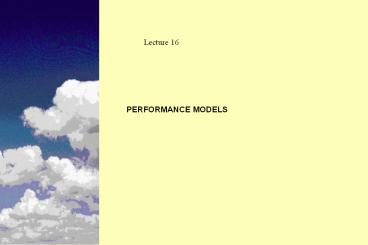PERFORMANCE MODELS - PowerPoint PPT Presentation
Title:
PERFORMANCE MODELS
Description:
Can be used to develop either deterministic or probabilistic models ... Models can be linear or non-linear, depending on the relationship between variables ... – PowerPoint PPT presentation
Number of Views:374
Avg rating:3.0/5.0
Title: PERFORMANCE MODELS
1
Lecture 16
PERFORMANCE MODELS
2
Instructional Objectives
- Understand use of performance models
- Identify common modeling approaches
- Understand methods for evaluating reliability
- Describe requirements for updating models
3
Overview
- Serviceability-performance concepts
- Deterioration as a representation of change in
performance
4
Uses of Performance Models in Pavement Management
- Network Level
- Project Level
5
(No Transcript)
6
Importance of Accurate Modeling
7
Performance Model Development Criteria
- Adequate database
- Inclusion of all significant variables that
affect performance - Adequate functional form of the model
- Satisfaction of the statistical criteria
concerning the precision of the model - Understanding of the principles behind each
modeling approach
8
Data Requirements
- Requirements vary depending on the type of model
being developed - Inventory Information
- Monitoring Data
9
Lack of Historical Data
- If historical databases are not available due to
changes in survey procedures, new rehabilitation
techniques, or other factors, other techniques
are available - incorporate input from experienced practitioners
- update the models as additional data are available
10
On-the-Diagonal Issue
11
Data Requirements
- Sufficient amounts of data must be used
- Data must be measured accurately and without bias
- Data must be representative
- Data must be maintained over time
12
Model Limitations
- Models must be used appropriately
- Limitations of models must be considered
- Boundary conditions should be identified and
satisfied
13
Deterministic vs. Probabilistic
- Predicted Occurrence
- Techniques
14
Mechanistic Models
- No purely mechanistic performance models have
been developed - Calculated stress and strain attributes from
mechanistic models can be used as the input for
an empirical prediction model
15
Mechanistic-Empirical Models
- Models developed using pavement response as the
dependent variable - Use elements of both mechanistic models
(fundamental principles of pavement behavior) and
empirical models (results from experience or
experiments) - N A (1/e)B
16
Regression Analysis
- A technique used to determine the relationship
between variables - Often used in agencies with historical databases
available
17
Subjective Approaches
- Used in agencies that do not have historical data
available - Can be used to develop either deterministic or
probabilistic models
18
Development of Deterministic Performance Models
- Very common modeling techniques in pavement
management - Predict a single number based on its relationship
with one or more variables - Can be empirical or mechanistic-empirical
correlations calibrated using regression - Condition is modeled as a function of other
variables
19
Regression Analysis
- Statistical tool used to establish the
relationship between two or more variables - Models can be linear or non-linear, depending on
the relationship between variables
20
Regression Model Forms
- Linear Regression
- Y a bX
- Multiple Linear Regression
- Y a0 a1X1 a2X2 . . . AnXn
- Non-Linear Regression
- Y a0 a1X1 a2X2 . . . AnXn
- Polynomial regression models may be constrained
- Least squares fit is used to improve the models
21
Deterministic Model Forms
22
Family Models
- Reduces number of variables
- Group pavement sections by characteristics
- Assume similar deterioration patterns
- Reflects average deterioration for family
- Allows ranges of values to be used for developing
families
23
Shift of the Family Performance Model
24
Advantages/Disadvantages to Family Models
- Advantages
- Disadvantages
25
Statistical Evaluation of Models
- Coefficient of determination (R2)
- Root mean square error (RMSE)
- Number of data points (n)
- Hypothesis tests on regression coefficients
26
Coefficient of Determination (R2)
- Provides an indication of how much of the total
variation in the data is explained by the
regression equation or performance curve - Network Level normally lt 0.9
- Project Level normally gt 0.9
27
RMSE
- Standard deviation of the predicted dependent
variable value for a specific value of the
independent variable - Project Level lt5
- Network Level gt 5
28
Other Tests
- Number of Data Points
- Hypothesis Test of Regression Constants
29
Limitation of Statistical Evaluations
- Statistical analyses only evaluate reliability
of model for data used in its development - A model can be statistically valid but not
representative of actual deterioration patterns
of network if poor quality data are used
30
Reliability of Performance Models
- Network Level
- Project Level
31
Reliability of Performance Models
32
Update Requirements
- Performance models must be updated regularly to
continue to reflect deterioration patterns - Feedback loops should be established to link
deterioration models with engineering practices.
33
Examples
- Washington DOT
- Deterministic models
- Illinois DOT
- Deterministic models
34
Washington State DOT
- Priority programming process
- Developed in-house
- Prediction models developed for combined ratings
- Raw distress severity and extent data are stored
so models can be modified as needed - Capabilities exist for statistical analysis of
performance trends - Performance models for individual sections
35
WSDOT Model Form
36
Fluctuations in Degree of Curvature in WSDOT
Models
37
Over Estimation of Performance
38
Illinois DOT Deterministic Models
- Condition Rating Survey (CRS)
- 1.0 to 9.0
- Type, severity, and extent of 5 predominant
distress - Automated the CRS Process
- Safety of expert panel
- Reduction in staff
- PaveTech vans purchased
- Calculation of CRS value
39
IDOT Family Models
40
IDOT Polynomial Approach
41
IDOT Trajectories
42
D-Crack Adjustments
- Asphalt concrete overlays deducts increased by
20 - Jointed reinforced concrete deducts increased by
20 - CRCP deducts increased by 50
43
Instructional Objectives
- Understand use of performance models
- Identify common modeling approaches
- Understand methods for evaluating reliability
- Describe requirements for updating models































